The Mosque of Rustem Pasha an Ottoman mosque located in Hasırcılar Çarşısı the Tahtakale neighborhood, of the Fatih district of Istanbul, Turkey.
Mosque of Rustem Pasha was designed by Ottoman imperial architect Mimar Sinan for Grand Vizier Damat Rustem Pasha (husband of one of the daughters of Suleiman the Magnificent, Princess Mihrimah). Built in 1560 by Sinan for Rüstem Paşa, son-in-law and grand vizier of Süleyman the Magnificent, it is a showpiece of the best Ottoman architecture and tilework, albeit on a small scale. It is thought to have been the prototype for Sinan’s greatest work, the Selimiye in Edirne. At the top of the two sets of entry steps there is a terrace and the mosque’s colonnaded porch. You’ll notice at once the panels of İznik faïence set into the mosque’s facade.
The interior is covered in similarly gorgeous tiles and features a lovely dome, supported by four tiled pillars. The preponderance of tiles was Rüstem Paşa’s way of signalling his wealth and influence İznik tiles being particularly expensive and desirable. It may not have assisted his passage into the higher realm, though, because by all accounts he was a loathsome character. His contemporaries dubbed him Kehle-i-Ikbal (the Louse of Fortune) because he was found to be infected with lice on the eve of his marriage to Mihrimah, Süleyman’s favourite daughter.
He is best remembered for plotting with Roxelana to turn Süleyman against his favourite son, Mustafa. They were successful and Mustafa was strangled in 1553 on his father’s orders. The mosque is easy to miss because it’s not at street level. There’s a set of access stairs on Hasırcılar Caddesi and another on the small street that runs right (north) off Hasırcılar Caddesi to the Golden Horn.
Exterior
The mosque was built on a high terrace over a complex of vaulted shops, whose rents were intended to financially support the mosque complex. Narrow, twisting interior flights of steps in the corners give access to a spacious courtyard. The mosque has a double porch with five domed bays, from which projects a deep and low roof supported by a row of columns
Interior
The Rüstem Pasha Mosque is famous for its large quantities of exquisite Iznik tiles, set in a very wide variety of beautiful floral and geometric designs, which cover not only the façade of the porch but also the mihrab, minbar, walls, columns and on the façade of the porch outside. These tiles exhibit the early use of a tomato-red color that would become characteristic of İznik pottery. Some of the tiles, particularly those in a large panel under the portico to the left main entrance, are decorated with sage green and dark manganese purple that are characteristic of the earlier ‘Damascus ware’ coloring scheme. No other mosque in Istanbul makes such a lavish use of these tiles.
The plan of the building is basically that of an octagon inscribed in a rectangle. The main dome rests on four semi-domes; not on the axes but in the diagonals of the building. The arches of the dome spring from four octagonal pillar two on the north, two on the south and from piers projecting from the east and west walls. To the north and south are galleries supported by pillars and by small marble columns between them.
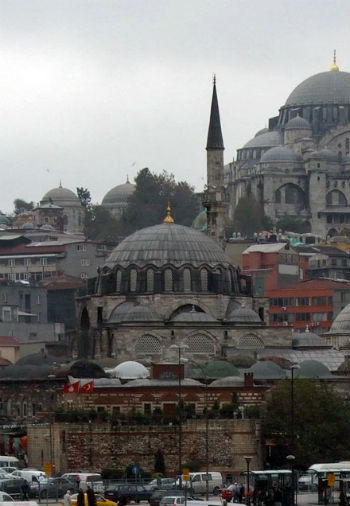
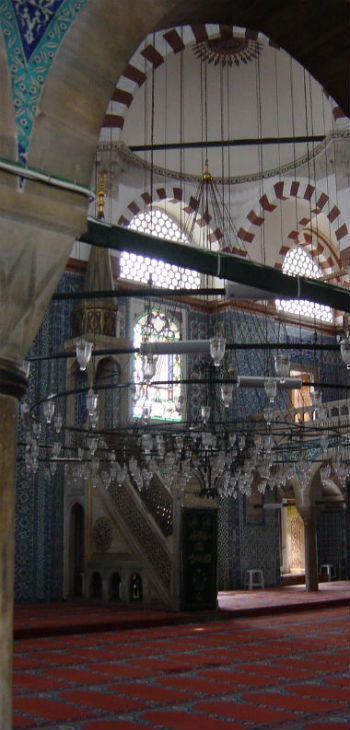
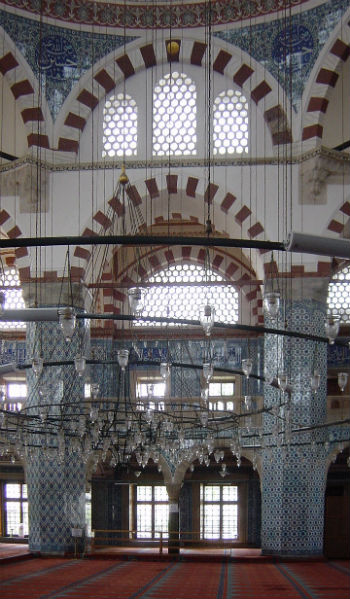
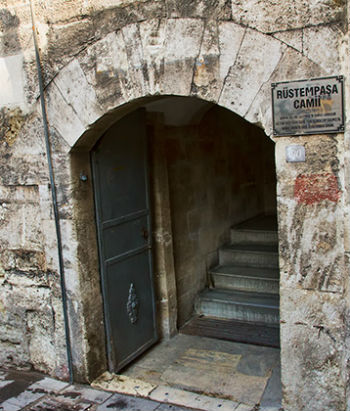
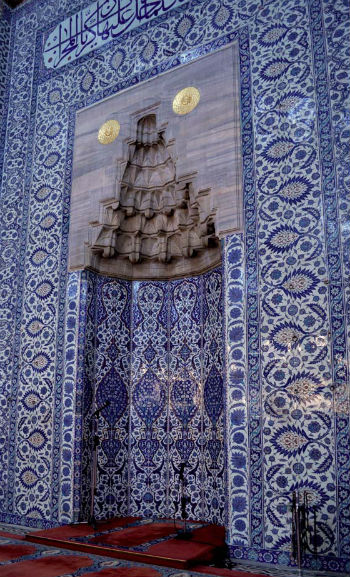


This small mosque near the spice market had priceless tile work and lovely arches. It was beautifully built by the same architect who buildt Suleymaniye Mosque
This is a beautiful small mosque near the bridge over the golden horn. It was very peaceful and quiet amongst the bustle of a local bazaar. It has an interesting history and is covered with beautiful blue tiles. Even the outside of the mosque has tiles.
this a small mosque built at the end of 16 th century has the magnificent samples of the Ottoman tiles.Really amazed when i got in.must be seen!
this is the finest collection of Iznik tiles. When these tiles were designed and fabricated, they were the highest quality in the world. A wonderful variety and combinations which can be viewed both up close and as an ensemble.
And, when I did finally see it I couldn't believe that I'd missed it as it stands out by being so high, just up from the River. Lovely tiles and so peaceful.
Ssmall but extremely beautiful. It is also surrounded by a market that is not much known by tourists which may be a plus for those who wish to wonder and explore areas that are still anonymous.
The tiles in this small mosque are spectacular. While it is a functioning Mosque, it is also a "tile museum." It is easy to reach from the spice market, down a few narrow market streets. The openings to the mosque can be hard to find as they are stairwells up off the street.
If you are in Istanbul and visited the Spice Market, I would suggest you pay a short visit to one of the most beautiful mosques in the city, Rustem Pasha Mosque. The Mosque was built in 16.century by the most important Ottoman architect, Sinan for Grand Vizier Rustem Pasha.
One of the most beautiful mosques in the city, and well worth the visit. Not as crowded as the Blue Mosque but every bit as moving.
As I recall this is a Sinan mosque. It's a small tile-encrusted jewel cleverly constructed on the slope between the market and the Golden Horn. Perect proportions. You cannot see better Iznik tiling.